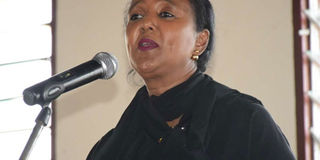Breaking News: KDF chopper crash kills five
Schools ill-equipped to support children with special needs: Report

Education Cabinet Secretary Amina Mohamed. She launched the report on March 22, 2018 at the start of the East Africa Conference on Inclusive Education at the United States International University-Africa. FILE PHOTO | NATION MEDIA GROUP
The education system in Kenya is still ill-equipped to support learners with disabilities and special needs, a joint report by the Kenya Institute of Special Education (Kise) and the Ministry of Education has revealed.
The National Survey on Children with Disabilities and Special Needs in Education, conducted between 2016 and 2017, shows that 11 per cent of all learners in Kenya have one or another form of disability.
DISABILITIES
The most common disabilities among learners include visual impairment (3.1 per cent), physical disability (3 per cent), intellectual disability (2.5 per cent), hearing impairment (1.2 per cent), speech and language (0.9 per cent), deafblind (0.2 per cent).
While a significant number of these children are enrolled in schools, the rate of school dropout remains high due to lack of support services in most learning institutions.
The report points out at glaring inadequacies in teachers trained to handle special needs education in assessment centres and schools in Kenya.
The majority of head teachers in primary integrated schools and special units (78.28 per cent) do not have any training in special needs education, for instance. Only 2.24 per cent of these have a Master’s degree in special needs education (SNE).
According to the report, the country lacks a policy framework to guide the implementation of inclusive education, while capitation for children with disabilities is not disaggregated according to type and severity of disabilities.
COUNTIES
Additionally, the curriculum used in schools does not meet needs of children with disabilities and special needs in education.
County governments, the report further indicates, do not support Educational Assessment Resource Service centres, with only three institutions (6 per cent) reporting having received support in terms of personnel, office space and equipment from their counties.
Understaffing, inadequate material, lack of appropriate tools and inadequate funding are some of the main challenges that most education assessment resource service centres face.
Advocacy, sensitisation and mobilisation of education for children with disabilities at the grassroots is also poor. Parents and guardians, according to the report, are not actively involved in education of their children with disabilities.
The distribution of children with disabilities in the country is even, with 51.2 per cent boys and 48.8 per cent girls.
Interestingly, 72.6 per cent of all learners with disabilities and special needs live in rural areas while with 27.4 per cent living in urban areas.
The purpose of the survey was to generate data that will be used to improve service provision to learners with disabilities in schools in Kenya.
These findings come at a time when the government is undertaking wide-ranging educational reforms, and the implementation of the competency-based curriculum (CBC) that was rolled out early this year. The new curriculum puts emphasis on nurturing the wholesome potential of learners besides their academic capabilities.
The report on findings of the survey was launched on Thursday by Education Cabinet Secretary Ambassador Amina Mohamed at the start of the East Africa Conference on Inclusive Education at the United States International University-Africa.
The two-day conference brings together education delegates from across the East Africa and Europe to discuss ways of enhancing access, equity, quality and opportunity for all learners.
The survey was conducted in all the 47 counties, targeting households, schools, education officers, non-governmental organisations, teachers and children aged between 3 and 21 years who suffer from physical, sensory, intellectual and psychosocial disabilities.
Education CS Dr Amina Mohamed described the findings as a great effort towards availing reliable data for purposes of planning and provision of quality education to children with disabilities and special needs in the education in the country.
“The findings of this survey are an eye-opener to stakeholders in education and a clarion call to re-strategise education in order to address the needs identified. This will ensure that services provided adequately address the child’s interests,” Dr Mohamed said, calling for collaboration between the government and other players to enhance education for children with disabilities and special needs.
Education Principal Secretary Belio Kipsang said that the government will introduce assessment centres for children with disabilities in all the counties.
“The ministry will work to ensure that all learning institutions are properly equipped and that all support facilities are made available to all learners requiring them to ensure that no child is disadvantaged in the learning environment,” said Dr Kipsang.
The assessment of the state of infrastructure to support learners with disabilities is expected to be completed by June this year, according to the ministry of education.
Among the recommendations made by the report include the need to develop and implement policy on inclusive education to enhance access, retention and transition of children with disabilities and special needs.
The report further proposes the need to separate capitation for children with disabilities in schools with regard to the type and severity of their disability.
It also calls for the review of the curriculum to ensure that it meets the needs of learners with disabilities, enhance staff trained in special needs education in assessment centres and schools to facilitate quality service delivery.





